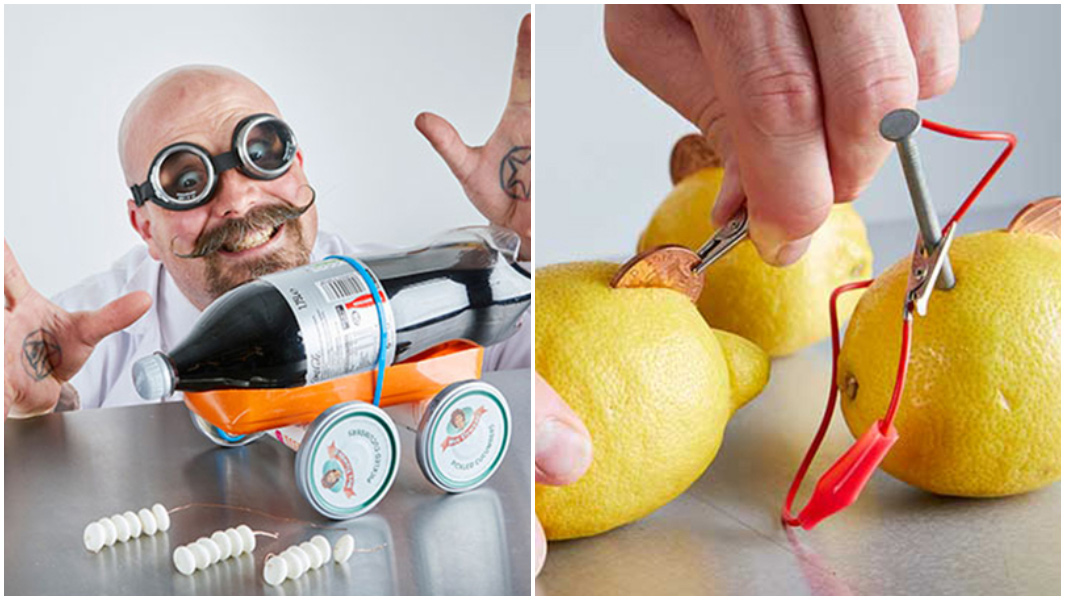Try these DIY science experiments at home 🧪️

National STEAM Day is on 8 November every year. STEAM stands for Science, Technology, Engineering, Art and Maths. These are some of the most important subjects you can learn at school and they can also be the most fun. 😄
To celebrate, here are two super science experiments you can try at home. You might even be able to break a record!
Watch Professor Orbax and his lab assistant Sweet Pepper Klopek show you how to do the experiments below. Make sure there is an adult around to help you. 👨🔬
Fruit Batteries
When life gives you lemons, make electricity! With just a few fruits, you can power a lightbulb. 🍋💡
If you're feeling speedy, you can attempt the record for the fastest time to light an LED with a fruit battery. Your parent/guardian can apply here for you.
What you’ll need
- 4 pieces of citrus fruit (lemons, limes and oranges work well)
- 4 galvanized nails (nails coated with a protective layer of zinc)
- 4 copper coins
- An LED bulb
- 5 crocodile clips
- A voltmeter

- To begin, cut a small slot in each of the four pieces of fruit.
- Insert a coin inside each slot. Make sure it’s in contact with the juicy bit of the fruit.
- Insert a nail into each piece of fruit.
- Now the four pieces of fruit need to be connected in a circuit. Attach the end of one crocodile clip to a nail, then attach the other end to a coin on a different piece of fruit.
- Continue to connect the circuit around in series.
- At the end, you’ll have two clips which are unconnected. Attach those to your LED bulb to watch it light up! 💡
How fruit batteries work
All batteries have three key parts: A positive electrode (cathode), a negative electrode (anode) and a fluid connecting the two (electrolyte). Once the electrodes are linked up, the electrons begin to flow and electricity is created. ⚡️
Your fruit batteries work in the same way. The nails act as the positive cathodes and the copper coins are the negative anodes. The juice inside the fruits acts as the electrolyte – the conductive pathway for the electricity to flow. Electrons travel through the crocodile clips to complete the circuit.🐊
Mentos® & Soda Car
If you’ve ever dropped Mentos® inside a soda bottle, you’ll know that it makes a very messy, fizzy explosion. But have you ever thought of using it to power a car? 🥤🚗
The record for the farthest distance by a Mentos® and soda bottle vehicle is 11.02 metres by Justin Yerace (USA). If you can beat it, your parent/guardian can apply here for the record.
What you’ll need
- Mentos®
- A soda bottle
- Anything around your house that can be used to make a basic car (e.g. straws, popsicle sticks, plastic containers, ketchup bottles – literally anything!)

- Begin by sticking together your bits and pieces to create a flat platform.
- Use four circular objects (like jar lids) to make four wheels.
- Attach the wheels to the platform to finish your car. You can ask an adult for help with this tricky bit!
- Attach the soda bottle on top.
Once you have built your car and attached your soda bottle, you’re ready to race! 🚗
To power your rocket car, you need to use your Mentos®. Once you put them into the bottle, your rocket car will zoom off, leaving behind a trail of sweet soda.
Top tip: To get your rocket car to go faster, poke a hole in the lid of the bottle. This nozzle will shoot the soda out faster, boosting your car's speed! 💨
How many marks can you get in the STEAM quiz?
